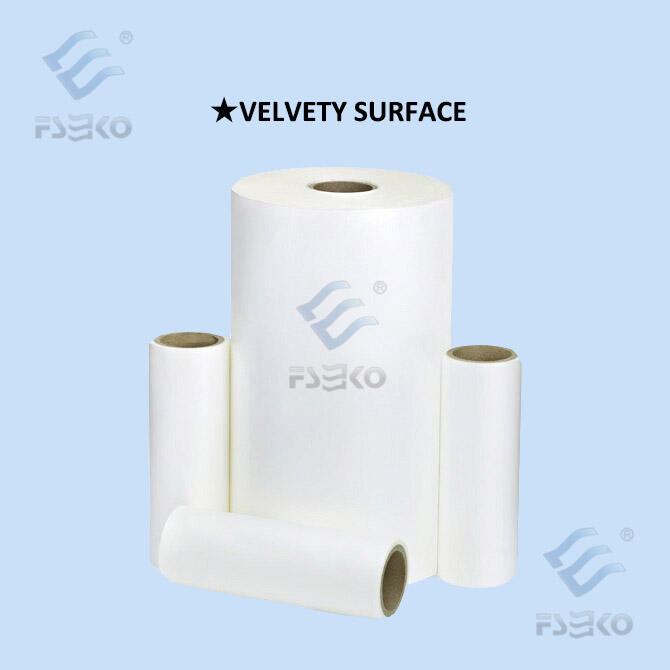Key Features of Soft Touch Thermal Lamination Film
Durability and Longevity: How Long It Lasts
Soft touch thermal lamination film typically lasts between 5 to 7 years under standard usage conditions, varying due to materials and environmental factors. This longevity makes it ideal for high-end applications where durability is key. Research indicates that laminated products experience reduced damage and longer lifespans compared to non-laminated items, further demonstrating the protective benefits of lamination. Explore soft touch lamination products.
Enhanced Protection Against Wear and Tear
Soft touch lamination film creates a robust protective barrier, shielding printed materials from scratches, moisture, and dust. This added coat provides up to 50% more durability during handling and storage. Such enhanced durability is particularly beneficial in high-friction environments where the risk of degradation is greater. With soft touch films, items can withstand a substantial amount of wear, ensuring they remain intact and visually appealing for extended periods. Learn more about film protection benefits.
Matte Finish and Luxurious Texture
The matte finish provided by soft touch lamination film offers a non-glare surface, perfect for enhancing readability in printed materials. This finish introduces a luxurious texture that can elevate the perceived value of products, leading to increased customer engagement. Studies indicate that consumers often favor matte options for their aesthetic appeal in packaging, which can positively sway purchase decisions. The tactile quality and visual appeal of soft touch lamination can effectively attract and retain customer interest. Discover more about the luxurious texture.
How to Apply Thermal Lamination Film Effectively
Step-by-Step Application Process
To apply thermal lamination film effectively, start by ensuring that your surfaces are pristine—clean and dry. This foundational step is crucial for achieving a smooth finish. Next, measure and cut the thermal lamination film to perfectly fit the dimensions of the product you'll be laminating. Once prepared, set up your laminating machine according to the film's thickness and the manufacturer's recommended temperature settings. As you proceed, feed both the document and the thermal film into the machine simultaneously. Ensure that the film covers the paper evenly to prevent any bubbling or misalignment, ensuring a professional look.
Best Practices for Optimal Adhesion
Optimal adhesion during lamination is essential, and selecting the correct film thickness plays a big role in achieving it. Using an appropriate thickness helps prevent common issues like bubbling or peeling that can degrade the final appearance. Routine maintenance of your laminating machine is also vital; it helps prevent potential disruptions that could affect the lamination quality. Additionally, it's wise to test adhesion on smaller sample materials before starting on larger projects. This pre-testing allows identification and resolution of any issues, ensuring consistent, high-quality results throughout your lamination batch.
Common Mistakes to Avoid
Avoiding common mistakes in the lamination process is key to achieving quality results. One prevalent error is neglecting the importance of precise temperature settings, which can lead to insufficient lamination or film damage. Furthermore, granting ample cooling time post-lamination is crucial, as rushing this step often results in warping, compromising the integrity of the item. Lastly, proper alignment of the film is non-negotiable. Misalignment can cause significant waste, as improperly laminated materials often need to be discarded, leading to both resource loss and increased costs.
Types of Thermal Lamination Films
Soft Touch vs. Glossy/Matte Variants
In the world of thermal lamination films, the choice between soft touch, glossy, and matte variants is crucial for meeting specific project requirements. Soft touch films are renowned for their luxurious tactile quality, making them ideal for premium packaging, while glossy films enhance the vibrancy and depth of colors. On the other hand, matte films eliminate glare, making them perfect for brochures and printed materials that demand high visibility under various lighting conditions. Each variant caters to unique industry needs, from enhancing aesthetic appeal to providing functional durability, thereby playing a pivotal role in the design and marketing strategies.
Eco-Friendly Laminating Film Options
As sustainability becomes increasingly vital, eco-friendly thermal lamination films are gaining traction. These films, crafted from biodegradable materials, help reduce landfill waste without compromising on performance. They offer the same protective qualities as traditional films, making them viable alternatives for conscientious companies. By choosing eco-friendly laminating options, businesses not only contribute positively to environmental conservation but also bolster their brand value and corporate responsibility, aligning with global sustainability trends and consumer expectations.
Specialty Films for Unique Applications
Specialty thermal lamination films are designed to meet particular business needs, such as UV protection or anti-scuff features. These films enhance product durability, making them suitable for challenging environments like outdoor displays or items subjected to heavy handling. Understanding specific project requirements enables businesses to select the most appropriate specialty film, ensuring that the final output is both functional and visually appealing. The right choice of specialty film can significantly extend the life and enhance the performance of laminated materials, opening new avenues for innovative applications.
Benefits of Eco-Friendly Thermal Lamination
Reducing Environmental Impact
Eco-friendly thermal lamination films play a significant role in reducing environmental impact due to their sustainable production methods and materials. These films often incorporate biodegradable components, which align with modern consumer demands for greener solutions. By embracing these eco-friendly options, companies not only help promote sustainability and recycling but also cater to the growing consumer base that values environmental stewardship. Research indicates that more consumers are willing to pay higher prices for green products, enhancing business growth while remaining environmentally responsible.
Performance Comparison with Traditional Films
Though traditional lamination films have been the standard, eco-friendly alternatives now offer comparable performance. Recent innovations have shown that these eco-friendly laminating films provide adequate durability and strong adhesion, often on par with their conventional counterparts. By choosing eco-friendly films, businesses not only meet their sustainability goals but also enhance their market position, demonstrating a firm commitment to environmentally responsible practices. This switch can provide competitive advantages in an increasingly eco-conscious market.
Where to Buy Quality Thermal Lamination Film
Factors to Consider When Choosing a Supplier
When choosing a supplier for thermal lamination film, evaluating several factors ensures a reliable purchase.
- Evaluate Reputation and Reviews: Assess the supplier's credibility by reading reviews from previous clients, which gives insight into the reliability and quality provided.
- Product Range: Examine the variety of products offered, focusing on the availability of eco-friendly options and different types of lamination film. A diverse product line reflects an ability to meet various needs.
- Pricing and Quality Balance: Ensure competitive pricing without compromising on quality, as subpar films might result in inferior lamination outcomes that could harm your brand image.
Trusted Brands and Industry Standards
Knowing which brands excel in the thermal lamination market can streamline decision-making and ensure you select high-quality products.
- Familiarize with Reputable Brands: Understand the key players in the industry that have reliably produced high-performance lamination films.
- Industry Standards: Learn about industry standards for quality to make informed purchasing decisions that align with your requirements.
- Exposure to Latest Innovations: Participate in trade shows and industry exhibitions to gain insights into top brands and the latest innovations in laminating film technology, which could benefit your business by keeping you ahead of trends.


